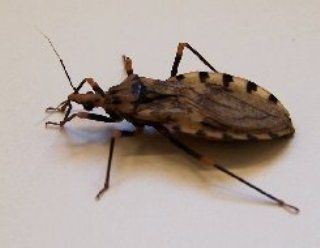Category Archives: SHTF
Experts say Chagas disease is ‘new HIV/AIDS of the Americas’
The New York Times reports experts from Baylor College of Medicine, Houston, Texas noted that nearly 8 million people have contracted the disease in the Americas and that most sufferers live in Bolivia, Mexico, Columbia and Central America. Fox News reports experts are worried that the disease that was once found mainly in Latin America is spreading to the U.S due to travel and immigration. About 30,000 people in the U.S. are believed to be infected with Chagas.
According to Daily Mail, the disease was named after a Brazilian doctor Carlos Ribeiro Justiniano Chagas, who discovered it in 1909. The disease is listed among the Neglected Parasitic Infections in the world. The list includes five other parasitic infections identified as top priority for public health action. Daily Mail reports experts say more than 10,000 people died of Chagas disease in 2008.
Chagas, like AIDS, has been linked to poverty and poor living conditions. The disease is found in the United States mostly among immigrants. Chagas disease is difficult to detect and symptoms may take several years to emerge after infection. If the infection is detected early, it can be successfully treated by an intensive course of drugs. But if detected late, the disease is difficult or impossible to cure. The New York Times reports that drugs for treating the disease are not as expensive as AIDS drugs but there are shortages in developing countries.The long period of incubation of the disease makes it difficult to detect it and the illness is often left untreated.
All blood banks in Latin America screen for traces of the disease. Daily Mail reports blood banks in the U.S. began screening in 2007.
Chagas infection is transmitted by the bite of reduviid blood suckling bugs called Triatomine bugs. The species are black wingless insects about 20 mm in length and are commonly known as “kissing bugs.”
When the bug bites its victim, it releases a single-celled parasite, called Trypanosoma cruzi into the blood stream. The parasite is closely related to the trypanosomes that cause African Sleeping Sickness. According to The New York Times, this explains why Chagas is sometimes called “American trypanosomiasis.”
The course of the disease goes through two phases, the acute and the severe stages.
The Huffington Post reports that even though there are significant similarities between Chagas and HIV/AIDS, there are also strong distinctions. HIV/AIDS is a sexually transmitted viral disease but Chagas disease is caused by a parasite called Trypanosoma cruzi. While HIV/AIDS attacks the body’s immune system, Chagas primarily targets the heart and digestive organs.
In the acute phase of illness, the disease simply incubates and may take years for symptoms to emerge. In the severe stage, symptoms such as constipation, abdominal pains, digestive disturbances and cardiac arrhythmia develop. The Huffington Post reports the National Institute of Health (NIH) says complications from Chagas disease can include inflammation of the heart, esophagus and colon, as well as irregular heartbeat and heart failure.
The parasite finally makes it way to the victim’s heart where it multiplies rapidly. Daily Mail reports that about a quarter of people who contract Chagas develop enlarged heart or intestines that may burst and cause sudden death.
According to The Huffington Post, the NIH reports that although it may “take more than 20 years from the original time of infection to develop heart or digestive problems,” the onset of symptoms can be dramatic.
Experts have long speculated that Charles Darwin contracted the illness during his five year trip on HMS Beagle when he was a young man in his 20s. Darwin died of heart failure 47 years after the voyage. He reported symptoms that experts think may be symptoms of Chagas, though others believe that some of the symptoms, such as heart palpitations, were psychogenic in origin.
Darwin, however, mentioned in his journal that he was bitten by a “wingless black bug” while traveling in South America during the voyage of HMS Beagle.
Zombie Outbreak – Miami ‘zombie’ attacker may have been using ‘bath salts’
A naked man who chewed off the face of another man in what is being called a zombie-like attack may have been under the influence of “bath salts,” a drug referred to as the new LSD, according to reports from CNN affiliates in Miami.
The horrific attack occurred Saturday and was only stopped after a police officer shot the attacker several times, killing him.
Larry Vega witnessed the attack on Miami’s MacArthur Causeway. He told CNN affiliate WSVN he saw one naked man chewing off the face of another naked man.
 Rudy Eugene
Rudy Eugene
“The guy was like tearing him to pieces with his mouth, so I told him, ‘Get off!'” Vega told WSVN. “You know it’s like the guy just kept eating the other guy away, like ripping his skin.”
“It was just a blob of blood,” WSVN quoted Vega as saying. “You couldn’t really see, it was just blood all over the place.”
Vega said he flagged down a passing police officer.
“When the officer approached him, told him to stop, pointed a gun at him, he turned around and growled like a wild animal and kept eating at the man’s face,” Fraternal Order of Police President Armando Aguilar told CNN affiliate WPLG.
Augilar said he suspects the attacker, identified as 31-year-old Rudy Eugene, was under the influence of “bath salts.” Four other drug use instances in Miami-Dade bear resemblances to Saturday’s attack, he told WPLG.
“It causes them to go completely insane and become very violent” and take off their clothes, Augilar told WPLG.
Dr. Paul Adams, an emergency room physician at Jackson Memorial Hospital in Miami, told CNN affiliate WBFS that the drug makes users delirious. They exhibit elevated temperatures and extreme physical strength, Adams said.
“I took care of a 150 pound individual who you would have thought he was 250 pounds,” WBFS quoted Adams as saying. “It took six security officers to restrain the individual.”
Adams said users have been known to use their jaws as weapons, according to WBFS.
According to a 2011 report from the National Institute of Drug Abuse, bath salts contain amphetamine-like chemicals.
“Doctors and clinicians at U.S. poison centers have indicated that ingesting or snorting ‘bath salts’ containing synthetic stimulants can cause chest pains, increased blood pressure, increased heart rate, agitation, hallucinations, extreme paranoia, and delusions,” according to the NIDA report.
In October, the Drug Enforcement Administration made possession of the stimulants in bath salts, Mephedrone, 3,4 methylenedioxypyrovalerone (MDPV) and Methylone, illegal under an emergency order. The order lasts for a year with a possible six-month extension.
The stimulants have been placed under restrictions or banned in 37 states, according to a DEA press release.
The victim of Saturday’s attack, whom police have not identified, was in critical condition at Jackson Memorial on Monday, according to the WPLG report. Augilar told WPLG that 75% to 80% of his face was missing.
Eugene had an arrest record, mostly misdemeanors, including a battery charge from when he was 16 that was later dropped, according to the Miami Herald.
He had been married but divorced in 2007, WPLG reported. His former wife told the station that Eugene had been violent toward her.
Homeless people near where the attack took place said Eugene was often seen around the area looking confused, according to WPLG.
Real Life Zombies
The thought of our bodies walking around and operating without our personal conscious or as the more spiritual believe without our soul is an idea that has intrigued and captivated the minds of human beings for centuries. Whether it be the living-dead and body snatchers of Hollywood movies or the stories of voodoo priests using potions to turn rivals into mindless drones to do their bidding, myths, movies, and stories about zombies have been a mainstay in human culture. But the idea of our bodies walking around without freewill or after we have passed may be closer to the realm of the natural than we all thought.
We have all been in the situation where we see a hideous bug in our sink or bathtub and instead of squishing it we take a more timid approach and turn the water on and drown the pest. Imagine you try to that and you watch the ugly sucker spin down the drain. You return to the bathroom later to make the horrifying discovery that the bug had returned from the dead. There are two possibilities: either you have a bathroom infested with bugs or you are dealing with a wolf spider, whose appearance is even more terrifying than its name.


